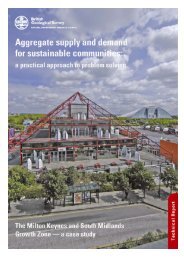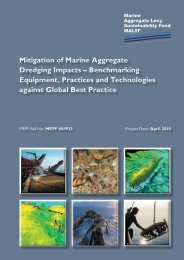creating environmental improvements through biodiversity
creating environmental improvements through biodiversity
creating environmental improvements through biodiversity
You also want an ePaper? Increase the reach of your titles
YUMPU automatically turns print PDFs into web optimized ePapers that Google loves.
Sustainable Aggregates Creating Environmental Improvements <strong>through</strong> Biodiversity<br />
Discusses the potential for natural water treatment systems to be incorporated into end-uses, including<br />
reedbeds – Slimbridge wildfowl collection as an example<br />
Discusses constructed wetlands in the context of water treatment and habitat creation<br />
Discusses ecological fish culture and ecological aquaculture as complementary uses to encouraging<br />
<strong>biodiversity</strong><br />
Presents examples of ‘eco-parks’ where natural water treatment, water supply, habitat development and<br />
recreation facilities are combined<br />
Provides guidance on site-specific constraints, strategic issues and decision making on various issues, including<br />
‘ecology’<br />
Discusses income and costs associated with habitat creation<br />
Mentions sterilisation of minerals in some cases to provide restoration material, leading to greater land<br />
requirement elsewhere - discusses techniques to minimise this<br />
Gives worked examples and advice on hypothetical restorations<br />
Points out that bigger sites are generally better for producing valuable restorations (but that public opinion<br />
and multiple ownership may cause problems in approving large extraction sites)<br />
Recommends further work on floating islands and eco-developments, and supports an innovative approach<br />
to restoration<br />
Lists references and useful websites<br />
Impacts (Actual):<br />
The report describes a broad spectrum of issues for consideration in designing water-based quarry<br />
restorations, and may help to encourage experts in different fields to work together. It points to a number of<br />
sources for further guidance on specific habitats, which would be useful to various readers. It also describes<br />
some innovative approaches to restoration, which may be more or less effective but provide an interesting<br />
basis for further discussion.<br />
Impacts (Potential):<br />
The report could help to raise awareness of <strong>biodiversity</strong> issues among experts from other fields - particularly<br />
hydrology (and vice versa), especially if dissemination was specifically targeted to those audiences.<br />
Potential Expansion:<br />
Further study could be carried out on some of the approaches the report describes. A proposal has been<br />
submitted to the MIRO MIST programme to do this. It will focus on the viability of floating wetlands for the<br />
restoration of wet mineral workings, and opportunities for sustainable rural regeneration <strong>through</strong> waterbased<br />
quarry restoration.<br />
Dissemination:<br />
‘Priority was given to the dissemination of information <strong>through</strong> a specifically constructed website (www.<br />
quarry-restoration.com) and presentations to the Steering Group Committee’.<br />
62

















